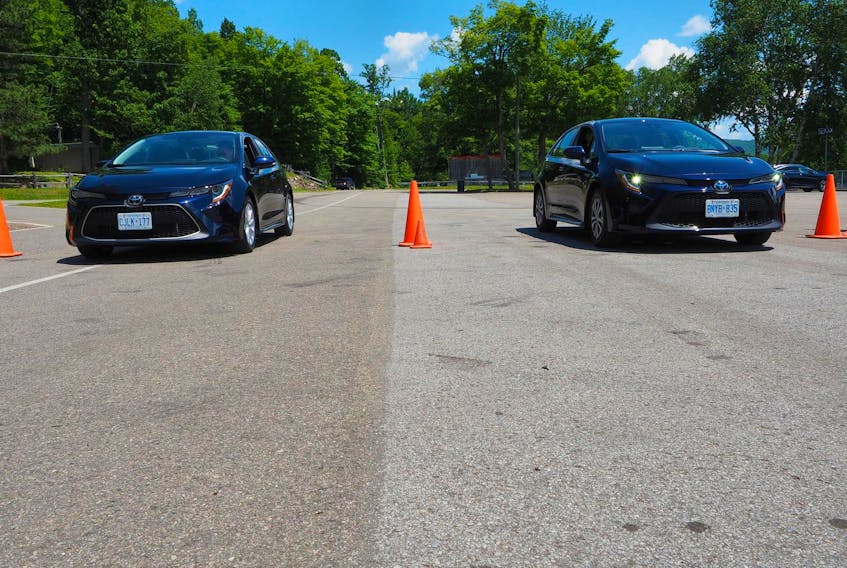Recently, your writer spent an afternoon partaking in some interesting driving exercises with various Toyota models, including the (very) highly-anticipated new GR Supra, which has been reincarnated for model-year 2020.
There’s a test drive feature coming on that little rocket, very soon.
Today, a feature of a different sort involving an unlikely drag race (on a closed course, with professional drivers like yours truly at the helm).
In the left lane?
A 2020 Toyota Corolla sedan, in XLE trim grade. This machine is new for this year, rides Corolla’s latest platform, and packs Corolla sedan’s best-yet blend of looks, feature content, and safety tech.
Under the hood? A 1.8-litre four-cylinder engine, good for 139 horsepower. That’s routed to the front wheels, via a shift-free continually variable transmission.
If you like, you can order your Corolla with a manual transmission, Toyota’s way of proving they care about driving enthusiasts.
In the right lane?
A 2020 Corolla hybrid. For all intents and purposes, the cars are identical, save for the engine. In the Corolla hybrid, a modified version of the 1.8-litre gasoline engine is teamed up with an electric motor drive system and self-recharging battery, to the benefit of fuel consumption and, as it turns out, performance.
The Corolla hybrid also comes with a CVT transmission, front-wheel drive, and total system power output is rated at 121 horsepower — some 18 less than the non-hybrid.
It was a drag race like any other: The two machines were lined up, side by side, a flag was dropped, and both drivers immediately applied full throttle.
The result was surprising and may prove perplexing to many folks who still live in Narnia and think hybrid or electrified cars are slow and pudgy.
Launched from a standstill, time and again (I personally ran this drag race times times in both machines) the result was identical: The Corolla hybrid smokes the Corolla, despite the lower power output.
And we’re not talking just a little bit, either.
The Corolla oozes off the line gently, picking up steam as the revs climb, several car-lengths later.
By this point though, the Corolla hybrid has pulled a half car-length ahead. It jumps off the line, instead of oozing off the line. The throttle response is more immediate and sudden. The car wakes up and gets hauling along much more quickly. The sustained pull almost calls a turbocharged engine to mind.
Then, the Corolla Hybrid opens the gap.
It’s actually hilarious. The Corolla hybrid clearly and consistently blows the doors off of the Corolla. It’s also quieter. Did I mention it uses considerably less fuel?
By the end of our little drag-strip, with speeds approaching about 95 km/h, the Corolla hybrid had left the standard Corolla in the dust. It gets the jump off the line, and then keeps opening the gap. At no point in this race is the Corolla hybrid not in the lead.
By my estimation, the Corolla would eventually pass the Corolla hybrid — though likely, at an unusably high velocity.
Translation? In city and highway driving, the Corolla hybrid is the (much) quicker car. And that’s with less horsepower.
Here’s why: A gasoline engine makes a certain peak amount of power, but only at a certain engine speed. Below (or above) that peak RPM, the gasoline engine makes less power. This ties into what some folks call the power-curve — a sort of sweet-spot, typically toward the top of the rev counter, where the engine is performing its best.

The non-hybrid Corolla makes 139 horsepower when the engine is in that sweet spot, and less than 139 horsepower, everywhere else on the tachometer. This means there’s a little waiting required, before the engine really gets things steaming along.
In the Corolla hybrid, the gasoline engine works the same way, but the electric motor is the star of the show.
Next time you make a frozen adult beverage in your smoothie-blender, watch how quickly the rotating blades come up to speed when you turn the blender on. This happens immediately, because electric motors have no power curve, and no sweet spot. Simply, the full output of the electric motor is available the moment sufficient current is applied to the motor, which is to say, immediately.
And while the Corolla Hybrid’s electric motor is a fuel-saving component, it also enhances performance, too. Put your boot down, and the electric motor’s immediate power combines with the gasoline engine’s power curve, for harder-hitting acceleration that stays on stronger, for longer.
Put another way, at full throttle in a hybrid, you’ve got the combined efforts of two propulsion systems driving the wheels and one of those is a torque-gushing all-star, which picks up the slack when the gas engine isn’t yet in its sweet-spot.
For those able to cough up the few extra bucks for a Corolla Hybrid (pricing from the mid-twenties), it’s a no-brainer: a faster car that’s easier on fuel.
And with the market shifting more toward electrification, shoppers will soon have more options to access this fuel-saving and performance-enhancing technology. Toyota alone has recently expanded their electrified offerings by way of models like the latest RAV4 Hybrid, and a new AWD-equipped Toyota Prius Hybrid.
More electrified models can be expected from Toyota and many other automakers. It’s always nice to have choices and especially ones that perform better while using less gas.









